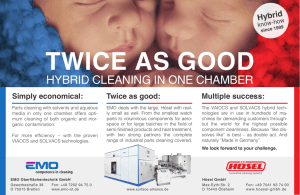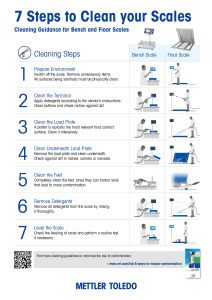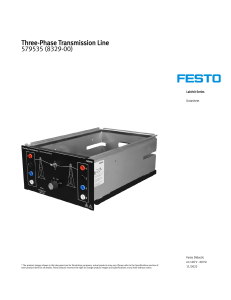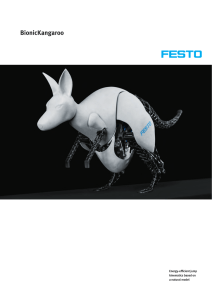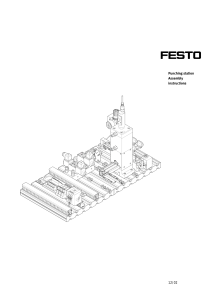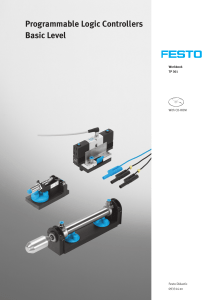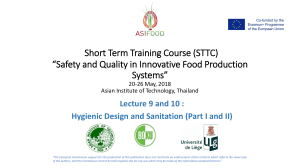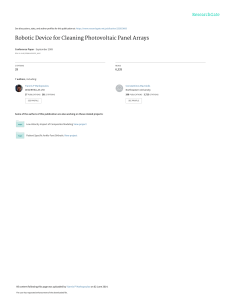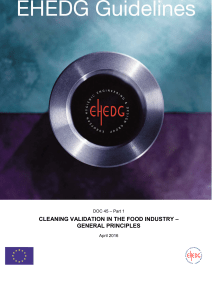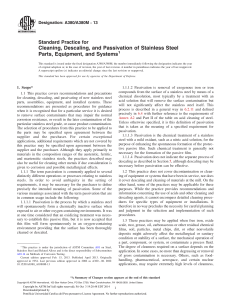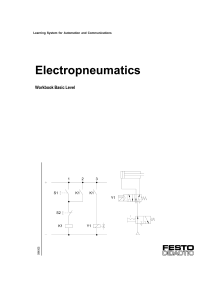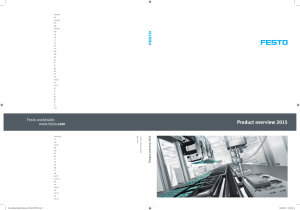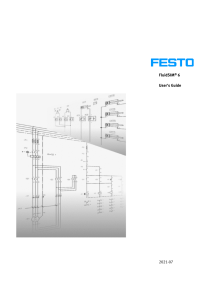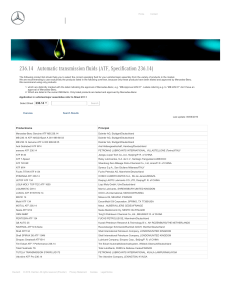White Paper - Food Safety
Anuncio
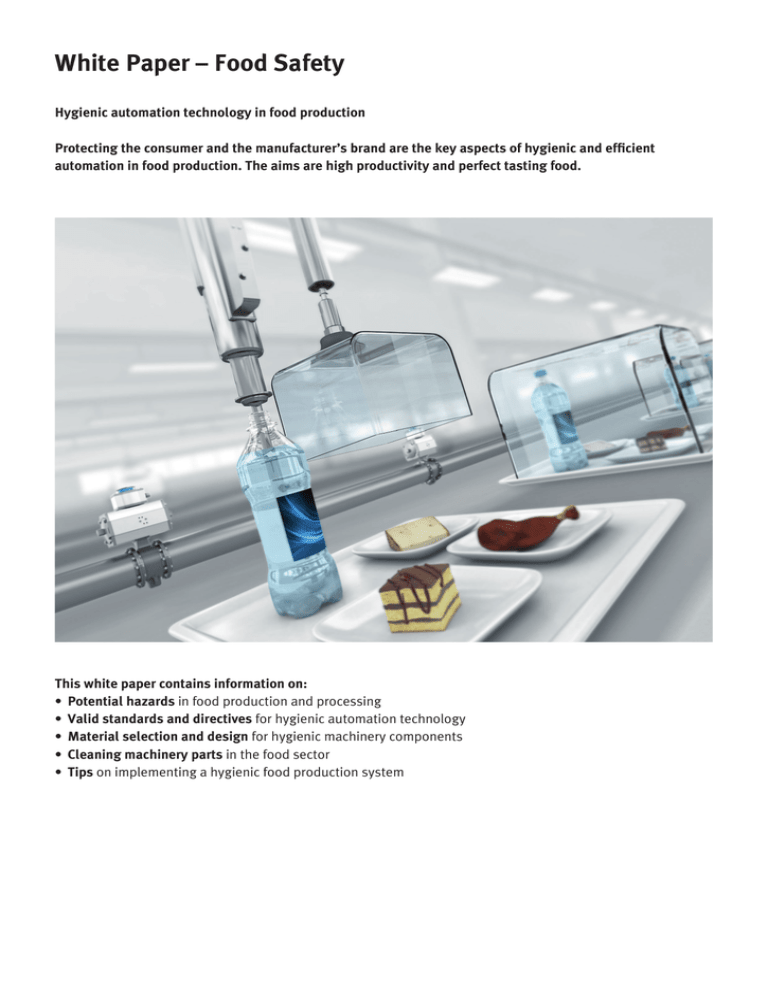
White Paper – Food Safety Hygienic automation technology in food production Protecting the consumer and the manufacturer’s brand are the key aspects of hygienic and efficient ­automation in food production. The aims are high productivity and perfect tasting food. This white paper contains information on: • Potential hazards in food production and processing • Valid standards and directives for hygienic automation technology • Material selection and design for hygienic machinery components • Cleaning machinery parts in the food sector • Tips on implementing a hygienic food production system Recognising and preventing risks The three production zones Salmonella in sausages, listeria in cheese – the list of food scandals is endless. Significant risks in the food sector are caused by: The European standard EN 1672-2, Food processing machinery – Basic concepts, defines three production zones: • Biological factors: decay caused by micro-organisms and their toxins • Chemical factors: cleaning and disinfecting agents and lubricants • Foreign particles: from machines, often caused by corrosion or abrasion, or from other sources The food zone This zone encompasses all system parts and components that are mounted directly in the food flow and come into contact with foodstuffs. Food may become contaminated and end up back in the ­product flow. System parts and components that come into contact with foodstuffs must be easy to clean and disinfect. They should be corrosion-­ resistant, non-toxic and non-absorbent. A smooth, continuous or sealed surface reduces the chance of food getting caught and leaving residue that is difficult to remove, making it a contamination risk. In addition, only special food-compatible lubricants may be used. When ensuring a machine’s design is hygienic, all the risks must be taken into account, and action must be taken to prevent or reduce these risks. The basics – standards and directives The splash zone In the splash zone, machine parts and components come into direct contact with foodstuffs, but the food does not end up back in the ­product flow. Nevertheless, these parts must be designed and built according to the same criteria as those in the food zone. Standards and directives form the basis that allows people to enjoy food without risk. Implementing these regulations during production reduces the risks for the manufacturer and the consumer. The aim of the EC Machinery Directive 2006/42/EC is the protection and safety of consumers and operators wherever food comes into direct contact with machine parts and components. The application of standards and directives for design (EN 1672-2/EHEDG Doc 8 and Doc 13) and materials (FDA CFR Title 21, ISO 21469, 1935/2004/EC) provides additional support for food safety. The non-food zone In this zone, the machine components do not come into contact with the product. However, the system parts used in this zone should be manufactured from corrosion-resistant materials and be easy to clean and disinfect, as sources of infection can develop over time. Machinery Directive 2006/42/EC This directive focuses on health and safety requirements put in place to protect machinery operators. Possible risks should be eliminated. Special hygiene requirements apply to machinery intended for the preparation and handling of food. The machinery must be designed and constructed in such a way as to avoid any risk of infection, sickness or contagion. This directive forms the basis for the EC conformity mark. © Copyright 2015, Festo AG & Co. KG For more information on standard EN 1672-2, please follow this link: http://www.festo.com/cms/en-gb_gb/14628.htm 2 Selecting the material In order to protect the food, the machine components must not deposit any substances during the production process that are harmful to health or that impair the taste or aroma, through either direct or indirect contact with the food. To make certain that the work carried out during the cleaning phase is safe, the materials used for the machine parts must not react with the cleaning agents or the anti-microbial chemicals (disinfectants). They must therefore be corrosion-resistant and mechanically stable to prevent the surface from being negatively affected. Common materials Austenitic stainless steel High-alloy stainless steel is usually the logical choice of material for the construction of a production system in the food industry. Typical materials include AISI-304, AISI-316 and AISI-316L (DIN material no. 1.4301/1.4401/1.4404), commonly known as V2A, V4A or INOX. Aluminium Aluminium is frequently used for construction. It is affordable and easy to work with and process. Typical aluminium grades include AlMg2Mn0.8, AlMgSi1 and AlMgSi0.5. Aluminium components can be rendered resistant to cleaning agents through the application of an additional coating or anodised oxide layer. Plastics Plastic components permitted to come into direct contact with food must comply with Regulation 1935/2004/EC and the Plastics ­Directive 10/2011 (replaces Regulation 2002/72/EU) or the approvals of the FDA (CFR 21, Sections 170-199). In addition to resistance to strain, ease of cleaning is also an important factor in the selection of suitable plastic materials. They must not give off or absorb any ­hazardous substances. Lubricants Lubricating greases and oils must comply with FDA regulations ­(especially Section 21 CFR 178.3570) or ISO 21469. For parts that will unavoidably come into sporadic contact with foods, approved ­lubricants as per NSF-H1 must be used. For more information on materials, please follow this link: http://www.festo.com/rep/en-gb_gb/assets/pdf/Food_manual_materials_en.pdf © Copyright 2015, Festo AG & Co. KG 3 Hygienic component design The application of EN 1672-2, ISO 14159 and DOC 8+13 of the EHEDG forms the basis for the hygienic design of machines and components. These standards take into account the fundamental design elements that can be used in the construction of components and systems. Surfaces A high surface finish is absolutely essential on components that come into contact with the product in order to reduce microbial contamination. This can be achieved by using a mean peak-to-valley height of Not 0.4 to accepted 0.8 µm within the food zone. Components with a peak-to-valley height of ≤ 3.2 µm are often used in the splash zone. Resistant surfaces and a high IP protection class, such as those of the pneumatic valve terminal MPA-C from Festo, fulfil the requirements for effective and efficient cleaning of these components. Connecting pieces, threads Connecting components such as screws, bolts, rivets and so on may cause hygiene problems. Open threads are difficult to clean and ­provide the perfect breeding ground for bacteria. Any threads that cannot be avoided should therefore be closed off with suitable covers and seals. Inner angles, corners and radii Very small radii and corners are always a hygiene risk as they are ­difficult to clean. The prescribed minimum radius is 3 mm. Not accepted Accepted Preventing the development of infection sources on the Festo ­stainless steel round cylinder CRDSNU: a threadless design can be used for the bearing cap to reduce the risk of contamination in typical applications. In addition, the self-adjusting end position cushioning system (PPS) is designed without adjusting screws, which are ­susceptible to contamination. ± 3 mm Accepted ± 3 mm High-quality surface finishes and large radii, such as those of the standard cylinder Clean Design DSBF from Festo, make cleaning the drive quick and easy. For more information on hygienic design, please follow this link: http://www.festo.com/rep/en-gb_gb/assets/pdf/Food_manual_design_en.pdf © Copyright 2015, Festo AG & Co. KG 4 The fundamental challenge of cleaning Clean and safe! All manufacturers are liable for their products. In the food and ­beverage industry complete product safety, especially from a microbiological standpoint, must be ensured to protect the consumer. As such, one important aspect involves designing components and ­systems with hygiene and ease of cleaning in mind in order to ­guarantee exemplary cleanliness, shortest possible cleaning times and minimal expense. Many potential sources of contamination in food and packaging systems such as bacteria, chemical influences or corrosion particles in the factory can be eliminated with just a few design tweaks. ­Easy-to-clean, corrosion-resistant system components make food production safer. When buying food, the consumer expects high-quality products that have been hygienically produced, dispensed and packaged by the food industry. That is why customer-specific process and factory automation solutions are an important part of any hygienic ­value-added chain. To avoid drives failing in aggressive environments, for example, the component materials must have certain qualities that make them suitable for reliably withstanding the prevailing ambient conditions, as well as guaranteeing full functionality and a long service life. This applies to both the materials used for the drive unit and those used for interface components, such as connections and seals. This requires a partner who is experienced in the field of automation technology and has the best possible expertise with regard to suitable technical components, as well as a thorough understanding of all the processes along the value-added chains of system manufacturers and food producers. This is the only way to protect the consumer and the manufacturer's brand. For more information on food safety, please follow this link: http://www.festo.com/foodsafety Reliable functionality, even when the lubricant has been washed out, thanks to dry-running seals from Festo’s sealing system. Seals and lubricants that comply with FDA regulations are recommended for system components that come into contact with food. Depending on the requirements of the specific application, there is a choice of valve types either for normal cleaning or for applications using intensive foam cleaning. Intensive cleaning of machine parts can also wash out the lubricating grease and impair the operation of the components. Using dry-running seals ensures that the washed out machine components still function reliably. For more information on cleaning, please follow this link: http://www.festo.com/rep/en-gb_gb/assets/pdf/Food_manual_cleaning_en.pdf © Copyright 2015, Festo AG & Co. KG 5 Author Mr. Alexander Wagner Head of Sector Management Food Industry Festo AG & Co. KG E-Mail: [email protected]
